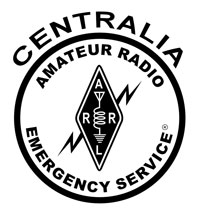 Annually thousands of Washington residents take part in the Great American Shakeout, a well rehearsed training scenario dedicated to teaching everyone how to safely respond to earthquakes. With training dates flexible for this event, Centralia Amateur Radio Emergency Service (ARES) team members selected Monday, October 18th – their normal training day – for this year’s earthquake exercise. The scenario, based around the 6.8 magnitude 2001 Nisqually quake, brought the team together to practice working with our relatively new Community Situation Status Tracking forms.
Annually thousands of Washington residents take part in the Great American Shakeout, a well rehearsed training scenario dedicated to teaching everyone how to safely respond to earthquakes. With training dates flexible for this event, Centralia Amateur Radio Emergency Service (ARES) team members selected Monday, October 18th – their normal training day – for this year’s earthquake exercise. The scenario, based around the 6.8 magnitude 2001 Nisqually quake, brought the team together to practice working with our relatively new Community Situation Status Tracking forms.
We began with a call up requesting ARES members, once their home situations had been deemed safe, to respond to an unknown staging area. In this exercise, both Centralia repeaters were offline due to the quake. Team members were advised to respond to the core areas of Centralia and, using only simplex frequencies, contact one of our mobile communication vans where they would be directed to a staging area near Centralia College for assignment. At the staging area, each team member was to show they had their vest, ARES ID, map books, radios, go-bags and mobile door shields. Next they were given a multi-block location within the city limits to find using map page and grid square in their map books. Once we were sure everyone knew where to go, each team member deployed. Some areas were business districts while others were residential streets. The Community Situation Status Tracking forms are designed to give the Incident Commander in our EOC a quick “snapshot” of the condition of his/her community after the earthquake. The form documents injuries, both minor and major, light and major structural damage, fires as well as gas leaks, broken water mains, power outages, bridge / road damage and visible damage to homes and businesses. Each survey takes only a couple of minutes once the team member arrives at their assigned location. That information is relayed back to the net control in the communications van where it would checked for accuracy and then sent to the amateur radio operator assigned to the Centralia EOC.
After any large disaster such as an earthquake, communities ramp up their emergency operations response but with power often out and many possible catastrophes present, the EOC must begin to prioritize its response. In order to prioritize that response, the Incident Commander must have some idea just how bad the situation is. Situation tracking forms completed by trained mobile volunteers such as an ARES team can produce this “community snapshot” in a relatively short time. There is no easier way to collect this information than using trained, trusted volunteers with a plan and direct communications to the Incident Commander in the EOC.
Monday turned out to be a dark, cold and rainy training night. The forms, new to us, will need to be changed and expanded somewhat but these kinds of changes are what we want from our field training process. For now, everyone worked through the training exercise safely and our communications systems operated exactly as planed. Thanks to our great volunteers who always work hard to keep our community safe.

